Introduction
Vegetables are excellent sources of natural antioxidants and vitamins, along with β-carotene and vitamin C that are very important for human health1,2. Several studies showed that vegetable-rich diets could reduce the risks of chronic diseases3. Some researchers suggest that the increase in chronic diseases is because people’s amount of fruit and vegetables is inadequate for a healthy diet 4,5. Some epidemiological studies have also shown that vegetable intake has a clear and consistent protective impact against the threat of various diseases such as cancer, retinopathy, and cardiovascular6.
According to a household survey in Bangladesh, the per capita vegetable consumption is 166.1 g, which is lower than the recommended minimum amount of 200 g. More than half of the population is suffering from various health-related issues due to malnutrition7. Green vegetables are abundant in micronutrients, so for developing countries, these vegetables’ intake can meet their nutritional demands at an affordable price8. A large number of antioxidants, AA, and carotenoids are available in green vegetables. Among all green vegetables, green beans, cabbage, and mustard leaf are commonly consumed during winter in the Sylhet region, Bangladesh. The bean’s green pods are good sources of protein, antioxidants, minerals, and vitamins9. Green bean is believed to be one of the most potent treatments for the deficiency in protein cures. Cabbage is commonly used in conventional medicine to relieve syndromes related to gastrointestinal problems and treat minor injuries, wounds, and mastitis because of its antioxidant, anti-inflammatory, and antibacterial properties10. A significant amount of research has also been done with beneficial phytochemicals of cabbage, especially their sulforaphane, indoles, and indole-3 carbinole (I3C). Such substances aid and regulate antioxidant processes and detoxification processes in the body, which replaces and eradicates toxins that cause cancer11. Several vitamins (vitamin A, vitamin C), essential minerals (Ca, Fe, Mg, K, and Zn), and phytonutrients are found in mustard leaves. The presence of phytonutrients are often recommended for anticancer properties12.
Vegetables are usually processed based on taste preference and process suitability. Mostly used domestic cooking are including boiling, steaming, and microwave13. These thermal treatments can induce a variety of effects on the physical characteristics, sensory properties, and bioactive components of vegetables. Both favorable and unfavorable results were reported, depending on the type and quality of fresh vegetables and the selection of cooking process2,14–16. Several studies reported that green vegetables’ bioactive content had been reduced after thermal treatment17, although some have shown no such effects18. Zhao et al. (2019)19 observed that the thermal treatment could change the bioactive content and health-promoting compounds of green vegetables. Dolinsky et al. (2015) reported an increase in the antioxidant capacity in cabbage, green beans, broccoli, kale during boiling, steaming, and microwave treatments, respectively.
However, the literature about the impacts of various cooking methods on indigenous vegetables’ physicochemical properties and bioactive compounds are still limited. This work was about to analyze and quantify the impacts of various methods of cooking on the physicochemical properties (pH, color) and bioactive components (AA, β-carotene, total flavonoid content, total polyphenol content, antioxidant activity) of some selected green vegetables (green bean, cabbage mustard leaf), widely consumed in Sylhet (Northeastern region of Bangladesh) and also find a suitable cooking method which might have the potential to preserve the physicochemical properties and bioactive contents of the selected vegetables.
Materials and Methods
Raw Materials
In December 2019, two kg of fresh and matured green mustard leaves (Brassica juncea), green beans (Lablab purpureus), and cabbage (Brassica oleracea var. capitata) were collected from Bangladesh Agricultural Development Corporation (BADC) Agro Service Center, Kumargaon, Sylhet, Bangladesh. The visually discolored, diseased, and damaged samples have been excluded in order to reduce biological variability. All of the samples were not uniform in length, diameter, or weight. Then vegetables were washed with tap water, and surface water was removed by putting on the blotting paper. The uneatable portions were manually removed by a sharp knife, and edible portions were separated and divided into 4 portions of 300 g for each application. Leafy vegetables were shredded (1 cm chiffonade cutting), and beans were cut to 1 cm thin slices to achieve the same texture in the same cooking time. These samples were vacuum packed in low-density polythene bags and stored at -22 ºC in a freezer until further analysis.
Cooking Methods
Boiling
Sample (100 g) was added to 150 ml of water in a hot water bath at boiling temperature (100 ºC) and boiled for 5 min. Then the excessive water was drained off18.
Steaming
Sample (100 g) was spread uniformly on a tray in a water bath sealed with a lid and steamed under atmospheric pressure using water vapor produced from 100 ºC boiling water for 7.5 min. The temperature of samples was reduced promptly using ice18.
Microwave
Sample (100 g) was mixed with 6 ml of distilled water in a glass dish covered with a perforated cooking bag and placed in a commercial 900 W microwave oven for cooking (1 min). Water was drained off the samples and cooled rapidly on ice18
Physicochemical Analysis
pH
The samples were homogenized (Model: HG-15A, Daihan Scientific Co. Ltd., Korea), then pH was measured using a digital pH meter (Hanna, HI 2211, USA).
Color Measurement
The color of samples was determined by a colorimeter (Model: PCE-CSM4, PCE instruments, UK) method described by Rana20. The instrument was standardized before the measurements. To analyze all samples’ color, fresh and processed vegetables were ground to make a puree and put into a glass dish to measure the color values (H, L*, a*, and b*). All measurements were done in quintuple, and the average values were tabulated for each/every sample. The hue angle were calculated by using tan -1 (b/a), (when a > 0) and 180 + tan -1 (b/a), (when a < 0)21.
Analysis of Bioactive Components
Ascorbic Acid (AA)
The total AA content in fresh and cooked samples was evaluated using the method reported by Salkić et al. (2009)22with slight modifications. 1 g of sample mixed with 10 mL of 0.056M sodium oxalate were homogenized (Model: HG-15A, Daihan Scientific Co. Ltd., Korea) for 2 minutes. The extraction solution was allowed to stand for 5 minutes. After filtering the homogenate solution, 0.5 mL supernatant of the extract was mixed with 0.056 M sodium oxalate for the dilution to 5 mL. The absorbance was estimated in a UV– Vis spectrophotometer (Shimadzu, UV-1800, Japan) at 266 nm using 0.056 M sodium oxalate as blank. Calibration curves were constructed using the standard L-ascorbic acid.
β–Carotene
To determine the total carotenoids, 1 g of sample was mixed with 10 mL distilled water and homogenized for 2 min. After that, 5 mL of hexane was mixed, and vigorously stirred for 1 min, then kept for 5 min to enhance mass transfer, and lastly, stirred again for 1 min. The absorbance of the obtained supernatant was determined in a UV– Vis spectrophotometer (Shimadzu, UV-1800, Japan) at 452 nm23. All studies were done three times, and the study results were expressed as mg/100 g using calibration curves of β-carotene as standard.
Extract Preparation
For determining the extracts’ bioactive compound, samples were prepared following the method proposed by Zhang and Hamauzu (2004)24, with some modifications. Samples (10.00 ± 0.02 g) were placed into 40 mL of 60 % methanol (CH3OH) and homogenized (Model: HG-15A, Daihan Scientific Co. Ltd., Korea) for 2 min. Then, incubated for 45 min at 20 °C in a shaking incubator (SI-200, Korea). After that, the mixture was centrifuged (416G, Gyrozen, Korea) at 4000 rpm for 10 min and filtrated through a Whatman No. 4 filter paper. Subsequently, the extract was left to stand in dark conditions at 4 °C, and it served as a working solution for TPC, TFC, and DPPH radical scavenging activity determination. The stock solution was freshly prepared before analyses of a new batch.
Total Flavonoid Content (TFC)
To determine the flavonoid concentration, 0.5 ml extract was added to 1.5 ml of 95 % ethanol, 0.1 ml of 10 % aluminum chloride (AlCl3), and 0.1 ml of 1 M potassium acetate, and 2.8 ml of distilled water. Then incubated at room temperature for 40 min. After that, using deionized water as blank, the mixture absorbance was measured in a UV-Vis spectrophotometer (Shimadzu, UV-1800, Japan) at 415nm. Results were revealed as quercetin equivalent (mg QE/100 g) 25.
Total Polyphenol Content (TPC)
The total phenolic content (TPC) was found using the Folin-ciocalteu Phenol reagent as reported by Da Silva et al. (2011)26. 0.5 ml extract was mixed to 8.5 ml of distilled water and 0.5 ml of Folin-ciocalteu Phenol reagent. After keeping the mixture for 5 min at room temperature, 1 ml of 35% sodium carbonate solution was added. Then the mixture was vortexed and stored at room temperature for 20 minutes. The absorbance was measured in a UV-Vis spectrophotometer (Shimadzu, UV-1800, Japan) at 765 nm. Rather than the sample, water was used as blank. Standard Gallic acid solutions of different concentrations were read against a blank to construct a calibration curve. TPC was expressed as mg of Gallic acid equivalent per 100 gram (mg GAE/100 g).
Antioxidant Activity (DPPH Radical Scavenging)
The extract’s antioxidant activity was evaluated by the 2,2-diphenyl-2-picryl-hydrazyl (DPPH) radical scavenging method described by Adiletta et al. (2018)27. At first, 100 μl of extracts were added to 1.4 ml of DPPH radical methanolic solution (0.1 mM in Methanol), where 0.0039 g of DPPH sample was dissolved in 100 ml methanol, and the solutions were kept in the dark place for 30 min. The continuation of the reaction contributed to a transition in color from yellow to purple owing to a decrease of the complex solution 2,2diphenyl-2-picrylhydrazyl (DPPH), as measured in a UV-Vis spectrophotometer (Shimadzu, UV-1800, Japan) at 517 nm at 25 °C (Asample). Rather than the sample, Blank was prepared with water (Acontrol) and the absorbance were recorded. The sample DPPH radical was determined from:
![]()
Where,Abscontrol= the absorbance of control at the initial time
Abssample= the absorbance of the sample.
Statistical Analysis
All results have been expressed as the mean ± standard deviation (SD) using SPSS software (SPSS Inc., Chicago, IL, USA). One-way analysis (ANOVA) and Tukey’s test were applied for comparing mean values. Any statistical difference in p< 0.05 was considered significant, and separate letters were used to indicate them.
Results and Discussion
The Effect of Cooking Methods on Physicochemical Characteristics
Raw, as well as cooked vegetables’ pH, is given in Table 1. It was observed that the pH of the green bean, cabbage, and mustard leaf showed no significant (p<0.05) change after being cooked (boiling, steam, microwave). Boiling of green bean and mustard leaf showed a slight decrease in pH values, and steam and microwave cooked green bean and mustard leaf showed a minor increase; this might be due to the hydrogen gradient in the vegetable proteins change for the high temperature 28. In contrast, boiling of cabbage showed a slight increase in pH values, and steam and microwave showed a slight decrease, but this was not significant. Dos Reis et al. (2015)29 also noted that the broccoli’s pH was highest after 5min boiling compared to other cooking methods because, in water, the food is less acidic.
Table 1: The Effects of Cooking Methods on Physicochemical Characteristics.
| Sample | Cooking treatment | pH | H | L* | a* | b* |
| Bean | Raw | 6.01±0.03ab | 109.44±1.76ab | 41.33±0.68a | -2.99±0.83b | 8.37±1.82b |
| Boiling | 5.95±0.02b | 104.63±1.2bc | 39.35±0.88a | -3.61±1.26ab | 12.49±1.20ab | |
| Steam | 6.07±0.02ab | 106.86±1.6ab | 35.34±0.62b | -4.71±1.24ab | 19.13±2.23a | |
| Microwave | 6.05±0.02a | 112.1±1.56a | 33.89±1.08b | -6.89±0.08a | 15.62±1.32a | |
| Cabbage | Raw | 6.36±0.04ab | 99.1±1.27b | 57.74±1.09a | -2.28±1.25b | 16.08±2.75b |
| Boiling | 6.41±0.02a | 101.27±1.07b | 55.55±1.77ab | -3.44±0.58b | 19.14±1.07b | |
| Steam | 6.29±0.03b | 103.26±2.25ab | 52.52±1.03b | -6.06±1.02ab | 22.2±2.33ab | |
| Microwave | 6.30±0.03b | 105.44±0.61a | 52.43±0.93b | -6.98±0.21a | 25.86±0.72a | |
| Mustard leaf | Raw | 6.87±0.03ab | 109.34±2.4b | 47.12±1.68a | -7.86±1.05ab | 22.37±0.15a |
| Boiling | 6.78±0.03ab | 120.38±1.33a | 38.32±0.48b | -10.4±0.45a | 17.78±0.86b | |
| Steam | 6.89±0.01a | 116.18±1.38ab | 35.07±3.32b | -6.8±0.46b | 13.84±0.88c | |
| Microwave | 6.85±0.03b | 121.13±2.44a | 41.17±4.23ab | -9.71±0.62a | 17.88±0.87abc |
All the values in the table are mean ± SD of three independent determinations. Samples in the same row with different superscript letters differ significantly at P<0.05
Color is one of the highest quality characteristics affecting customer product preferences, attitudes, and purchasing behavior. Therefore, to maximize the quality and value of food, color measurement and analysis are crucial in post-harvest handling and bioprocessing. The fruit and vegetable color reflects the presence of the various pigmented components. Chlorophyll is known to give most vegetables the green color, while carotenoids are generally responsible for the orange or yellow color 30. The hue angle (H) in green vegetables, fruits, and meats was extensively used to assess color parameters31. Hue angle values of vegetables changed based on the cooking techniques and vegetable type. Hue angles increased significantly after microwave cooking in all three vegetables than raw, which implies an increase in the brightness of greenness32.
On the contrary, bean and cabbage hue angle values remain unchanged during boiling and steaming, but mustard leaf hue angle values increased significantly. In comparison to other cooked vegetables, all microwave-cooked vegetables get the most significant hue angle. This may be due to the development of many chlorophyll derivatives, as many chlorophyll compounds do not alter chromophores’ properties and the color of their precursors33. Also, it could be due to the lowest exposure time used for microwave cooking. Turkmen et al. (2006)33 also reported a similar hue angle for different greeny vegetables after boiling (5min), steaming (7.5 min), and microwave cooking (1.5 min) treatment. The color parameter L* implies lightness. Steam and microwave cooked showed a significant decrease of lightness in green beans and cabbage. L * values of the mustard leaf were decreased significantly with boiling and steaming, which implies a reduction in green lightness. Higher L* values were found in raw vegetables, green beans and cabbage cooked with boiling, and mustard leaf cooked with microwave, which indicates a higher light green color. The color parameter a* means red-green intensity, only microwave cooking of green bean and cabbage showed a significant change. Higher a* values were found with microwave cooked samples compared to others, indicating an intense green color. This corroborates with the hue angle findings, which were theorized to the chlorophyll derivatives developed during microwave-cooking33. The color parameter b* implies yellow-blue intensity, steam and microwave cooked green bean and cabbage showed a significant increase, indicating a higher greenish-yellow color. Boiled and steamed mustard leaves showed a significant decrease of b* values. Dos Reis et al. (2015)29 observed that lightness (L*) of broccoli and cauliflower declined compared with raw vegetables after cooking (boiling, steaming, microwaving, and sous vide). This study also revealed that cooking by various methods (boiling, steaming, and microwaving) reduces lightness (L*) compared to raw.
The Effect of Cooking Methods on Bioactive Compounds
Ascorbic Acid (AA)
Vegetables are susceptible to loss of AA. From Figure.1, it can be shown that the AA of vegetables decreased significantly (P<0.05) compared to raw vegetables in all three cooking methods. It was observed that boiling showed a higher significant reduction in AA compared to other methods. In contrast, microwave cooking showed a lower significant decrease in green beans and cabbage, while steaming showed a significantly lower AA reduction in mustard leaves than other methods. Boiled vegetables have the lowest AA value in comparison with other cooked vegetables. The use of a higher amount of water, surface area, and temperature during boiling also contributed to more leaching of AA34.
On the other hand, microwave-cooked vegetables got the maximum value of AA than other cooked vegetables. It could be due to use the lowest time and less water for microwave cooking. Yang et al. (2019)35 reported that after cooking for 5 min, boiling caused a higher loss of AA than steaming and microwaving of broccoli. Due to reduced contact at a lower temperature with water, steaming and microwaving retained higher AA levels than boiling reported by Lee et al. (2018)2 after boiling, steaming, and microwave cooking time various types of vegetables.
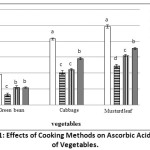 |
Figure 1: Effects of Cooking Methods on Ascorbic Acid Values of Vegetables. |
β-Carotene
Carotenoids are found to be essential antioxidants and are more stable during heat processing. β-carotene of all three raw and cooked samples (green beans, cabbage, and mustard leaf) is shown in (Figure 2). β-Carotene was increased significantly (p<0.05) in cabbage and mustard leaf after all three cooking methods and green bean had not shown any significant change after three cooking methods. From Figure 2, it is clear that β-Carotene value increases in all cooked vegetables. Cooking of food may enhance carotenoid extraction by softening the plant walls and interrupting the carotenoid-protein structures2. The bioavailability of carotenoids are found a higher amount in processed foods than raw materials15. Steam-cooked vegetables have shown the highest β-carotene value in all three samples. Raw samples of cabbage and mustard leaf have shown the lowest values, and microwave cooked sample has confirmed the lowest β-carotene value in the green beans. During boiling for 8 min, Chang et al. (2013)17 found that the β-carotene increased after cooking in some vegetables. Dos Reis et al. (2015)29 reported a considerable increase in broccoli β-carotene content during microwave and steaming, consistent with the present study.
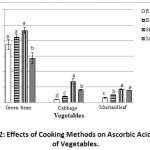 |
Figure 2: Effects of Cooking Methods on Ascorbic Acid Values of Vegetables. |
Total Flavonoids Content (TFC)
The total flavonoids content of vegetables is given in Figure 3. Only the flavonoids of green beans showed a significant decrease with boiling methods. All other methods and vegetables showed a slight change, but it was not significant. The highest flavonoids were found in mustard leaf compared to the other two vegetables. After cooking, the only microwave processed samples showed a slight increase in flavonoids value. Steaming and boiling showed a decrease of flavonoids in all three vegetables. Dos Reis et al. (2015)29 and Wu et al. (2019)19 observed similar findings in cauliflower and broccoli, where the flavonoids decreased with cooking methods (boiling, steaming, microwave, and sous vide). The heat-induced degradation and leached out flavonoids into the waters may be the reason for the loss of flavonoids after cooking.
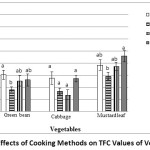 |
Figure 3: Effects of Cooking Methods on TFC Values of Vegetables. |
Total Phenolic Content (TPC)
Figure 4 illustrates the amount of phenolic content of vegetables. The raw vegetables contained 13.21±1.07b to 43.1±1.47ab mg GAE/100 g total phenolics and the highest amount found in mustard leaf followed by green bean, cabbage. After boiling, the TPC of green bean, mustard leaf, and cabbage decreased significantly compared to raw vegetables. This decrease in phenolic content could be related to lixiviation phenomenon, which is dependent on temperature, time, and volume of cooking water36. Steam cooking showed a significant level of increase in total phenolic in all three vegetables. With microwave cooking, the TPC of green bean and mustard leaf also increased significantly, but a slight decrease in cabbage was detected though this was not significant. Dos Reis et al. (2015)29 and Turkmen et al. (2005)18 also observed, the phenolic content increased during microwave and steam cooking of selected vegetables. This could be attributed to the release of free phenolics from the hydrolysis reaction of tannins, triggered by the increased pressure and higher temperature during steam cooking and/or microwave irradiation37. Moreover, steaming and microwave cooking utilized less water and/or a shorter time than boiling; consequently, more TPC was retained in vegetables.
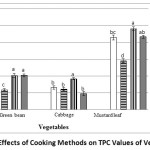 |
Figure 4: Effects of Cooking Methods on TPC Values of Vegetables. |
Antioxidant Activity
DPPH radical scavenging activity was used for the determination of vegetables’ antioxidants. Among the three selected vegetables, mustard leaf showed the most considerable scavenging activity, accompanied by cabbage and green beans (Figure 5). The scavenging activity of vegetables changed based on the cooking techniques and vegetable type. The scavenging activity of green beans increased significantly after all cooking methods. Cabbage and mustard leaf showed a significant increase with boiling and remained unchanged with microwave cooking. This may be due to the boiling process; cell walls and subcellular compartments may destroy and thus release potent radical-scavenging antioxidants.
In contrast, the scavenging activity of cabbage decreased, and the scavenging activity of mustard leaf increased with steam cooking. Turkmen et al. (2005)18 showed that antioxidant activity increased by 15.90 % when it is boiled for 5 min, and broccoli’s total antioxidant activity stayed the same with microwave cooking that is consistent with the result as seen in this study. According to Dos Reis et al. (2015)29, brassica vegetables’ antioxidant activity increased after cooking (boiling, steaming, and microwave) compared to raw, which is also partially supported by the result shown in the present work. According to this study, cooking with various techniques influenced antioxidant activity. This discrepancy can be explained by various factors, including that the antioxidant activity derived from phenolics is higher in carotenoid-deficient vegetables36, owing primarily to their redox properties, which allow them to function as reducing agents, hydrogen donors, and singlet oxygen quenchers. There is frequently a correlation between TPC and antioxidant activity, and secondary metabolites, such as pigments and volatile constituents38, can also contribute antioxidant activity, but this requires further investigation.
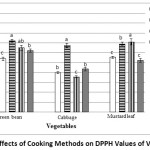 |
Figure 5: Effects of Cooking Methods on DPPH Values of Vegetables. |
Conclusion
There were no significant changes in pH after cooking in three green vegetables tested. The green color (negative a* and hue angle above 100o) of three vegetables (green bean, cabbage, and mustard leaf) improved after cooking. All three cooking methods showed a significant decrease in AA than raw, but microwave and steaming showed a lower significant reduction of AA than boiling. The highest AA was obtained in raw mustard leaves. The steaming process showed higher retention of β-carotene and TPC. Similar to steaming, microwaves also showed higher retention of total flavonoid content. The total antioxidants of green beans increased significantly after all cooking methods. After all, steaming was shown to preserve vegetables’ nutritional properties best compared to this analysis, and microwaves showed a moderate impact.
Acknowledgement
The authors express their gratitude to the Department of Food Engineering and Tea Technology of Shahjalal University of Science and Technology, Sylhet, Bangladesh, to provide technical facilities and allocate financial support through a research grant for coauthor Hasan Ahmad to conduct his research.
Sources of Funding
This study was not sponsored by any external funding agencies.
Conflict of Interest
The authors declare no conflict of interest.
References
- Ali I, Jaradat N, Zaid AN, Yousef E, Haimoni I, Yaseen A. The effect of different cooking methods on antioxidant activity of fruits and vegetables. J Mater Environ Sci. 2019;10(5):7.
- Lee S, Choi Y, Jeong HS, Lee J, Sung J. Effect of different cooking methods on the content of vitamins and true retention in selected vegetables. Food Sci Biotechnol. 2018;27(2):333-342. doi:10.1007/s10068-017-0281-1.
CrossRef - Cespedes EM, Hu FB. Dietary patterns: From nutritional epidemiologic analysis to national guidelines. Am J Clin Nutr. 2015;101(5):899-900. doi:10.3945/ajcn.115.110213.
CrossRef - Anderson JW, Baird P, Davis RH, et al. Health benefits of dietary fiber. Nutr Rev. 2009;67(4):188-205. doi:10.1111/j.1753-4887.2009.00189.x.
CrossRef - Dolinsky M, Agostinho C, Ribeiro D, et al. Effect of different cooking methods on the polyphenol concentration and antioxidant capacity of selected vegetables. J Culin Sci Technol. 2016;14(1):1-12. doi:10.1080/15428052.2015.1058203.
CrossRef - Shori AB. Screening of antidiabetic and antioxidant activities of medicinal plants. J Integr Med. 2015;13(5):297-305. doi:10.1016/S2095-4964(15)60193-5.
CrossRef - Mohammed Abdus Satter M, Khan MMRL, Jabin SA, Abedin N, Islam MF, Shaha B. Nutritional quality and safety aspects of wild vegetables consume in Bangladesh. Asian Pac J Trop Biomed. 2016;6(2):125-131. doi:10.1016/j.apjtb.2015.11.004.
CrossRef - Ebert AW. Potential of underutilized traditional vegetables and legume crops to contribute to food and nutritional security, income and more sustainable production systems. Sustain. 2014;6(1):319-335. doi:10.3390/su6010319.
CrossRef - Alkari S. Comparative Study of Indian Varieties of Lablab and Field Bean for Phenotypic and Nutritional Traits. Legume Genomics Genet. 2015;6(3):1-7. doi:10.5376/lgg.2015.06.0003.
CrossRef - Rokayya S, Li CJ, Zhao Y, Li Y, Sun CH. Cabbage (Brassica oleracea L. var. capitata) phytochemicals with antioxidant and anti-inflammatory potential. Asian Pacific J Cancer Prev. 2013;14(11):6657-6662. doi:10.7314/APJCP.2013.14.11.6657.
CrossRef - Zhang YJ, Gan RY, Li S, et al. Antioxidant phytochemicals for the prevention and treatment of chronic diseases. Molecules. 2015;20(12):21138-21156. doi:10.3390/molecules201219753.
CrossRef - Banerjee A, Datta J., Mondal N. Biochemical changes in leaves of mustard under the influence of different fertilizers and cycocel. J Agric Technol. 2012;8(4):1397-1411. doi:10.1016/j.jssas.2011.11.001.
CrossRef - Armesto J, Gómez-Limia L, Carballo J, Martínez S. Effects of different cooking methods on the antioxidant capacity and flavonoid, organic acid and mineral contents of Galega Kale (Brassica oleracea var. acephala cv. Galega). Int J Food Sci Nutr. 2019;70(2):136-149. doi:10.1080/09637486.2018.1482530.
CrossRef - Buratti S, Cappa C, Benedetti S, Giovanelli G. Influence of cooking conditions on nutritional properties and sensory characteristics interpreted by e-senses: Case-study on selected vegetables. Foods. 2020;9(5). doi:10.3390/foods9050607.
CrossRef - Mehmood A, Zeb A. Effects of different cooking techniques on bioactive contents of leafy vegetables. Int J Gastron Food Sci. Published online 2020:100246. doi:10.1016/j.ijgfs.2020.100246.
CrossRef - Pérez-Burillo S, Rufián-Henares JÁ, Pastoriza S. Effect of home cooking on the antioxidant capacity of vegetables: Relationship with Maillard reaction indicators. Food Res Int. 2019;121:514-523. doi:10.1016/j.foodres.2018.12.007.
CrossRef - Chang SK, Nagendra Prasad K, Amin I. Carotenoids retention in leafy vegetables based on cooking methods. Int Food Res J. 2013;20(1):457-465.
- Turkmen N, Sari F, Velioglu YS. Food Chemistry The effect of cooking methods on total phenolics and antioxidant activity of selected green vegetables. 2005;93:713-718. doi:10.1016/j.foodchem.2004.12.038.
CrossRef - Wu X, Zhao Y, Haytowitz DB, Chen P, Pehrsson PR. Effects of domestic cooking on flavonoids in broccoli and calculation of retention factors. Heliyon. 2019;5(3). doi:10.1016/j.heliyon.2019.e01310.
CrossRef - Rana R, Islam A, Sabuz AA, Hasan M, Ara R. Effect of Blanching Pretreatments on the Physicochemical and Drying Characteristics of Chui Jhal ( Piper chaba H.) Stem. Int J Food Sci Agric. 2020;4(4):482-491. doi:10.26855/ijfsa.2020.12.017.
CrossRef - Ramallo LA, Mascheroni RH. Quality evaluation of pineapple fruit during drying process. Food Bioprod Process. 2012;90(2):275-283. doi:10.1016/j.fbp.2011.06.001.
CrossRef - Salkić M, Keran H, Jašić M. Determination of l-ascorbic acid in pharmaceutical preparations using direct ultraviolet spectrophotometry. Agric Conspec Sci. 2009;74(3):263-268.
- Biswas AK, Sahoo J, Chatli MK. A simple UV-Vis spectrophotometric method for determination of β-carotene content in raw carrot, sweet potato and supplemented chicken meat nuggets. LWT – Food Sci Technol. 2011;44(8):1809-1813. doi:10.1016/j.lwt.2011.03.017.
CrossRef - Zhang D, Hamauzu Y. Phenolics, ascorbic acid, carotenoids and antioxidant activity of broccoli and their changes during conventional and microwave cooking. Food Chem. 2004;88(4):503-509. doi:10.1016/j.foodchem.2004.01.065.
CrossRef - Chang CC, Yang MH, Wen HM, Chern JC. Estimation of total flavonoid content in propolis by two complementary colometric methods. J Food Drug Anal. 2002;10(3):178-182.
CrossRef - Da Silva CHTP, Da Silva Peixoto Sobrinho TJ, De Almeida E Castro VTN, Da Cunha Amaral Lima D, De Amorim ELC. Antioxidant capacity and phenolic content of Caesalpinia pyramidalis Tul. and Sapium glandulosum (L.) morong from northeastern Brazil. Molecules. 2011;16(6):4728-4739. doi:10.3390/molecules16064728.
CrossRef - Adiletta G, Petriccione M, Liguori L, Pizzolongo F, Romano R, Di Matteo M. Study of pomological traits and physico-chemical quality of pomegranate (Punica granatum L.) genotypes grown in Italy. Eur Food Res Technol. 2018;244(8):1427-1438. doi:10.1007/s00217-018-3056-x.
CrossRef - Hajizadeh M, Salami M, Poursasan N. The effect of heat and pH on foam capacity of beta-casein. 2017;1(1):2012.
- Dos Reis LCR, De Oliveira VR, Hagen MEK, Jablonski A, Flôres SH, De Oliveira Rios A. Effect of cooking on the concentration of bioactive compounds in broccoli (Brassica oleracea var. Avenger) and cauliflower (Brassica oleracea var. Alphina F1) grown in an organic system. Food Chem. 2015;172:770-777. doi:10.1016/j.foodchem.2014.09.124.
CrossRef - Cömert ED, Mogol BA, Gökmen V. Relationship between color and antioxidant capacity of fruits and vegetables. Curr Res Food Sci. 2020;2:1-10. doi:10.1016/j.crfs.2019.11.001.
CrossRef - Pathare PB, Opara UL, Al-Said FAJ. Colour Measurement and Analysis in Fresh and Processed Foods: A Review. Food Bioprocess Technol. 2013;6(1):36-60. doi:10.1007/s11947-012-0867-9.
CrossRef - Guiné RPF, João M. Food and Bioproducts Processing Effect of drying treatments on texture and color of vegetables ( pumpkin and green pepper ). Food Bioprod Process. 2011;90(1):58-63. doi:10.1016/j.fbp.2011.01.003.
CrossRef - Turkmen N, Poyrazoglu ES, Sari F, Sedat Velioglu Y. Effects of cooking methods on chlorophylls, pheophytins and colour of selected green vegetables. Int J Food Sci Technol. 2006;41(3):281-288. doi:10.1111/j.1365-2621.2005.01061.x.
CrossRef - Jiang Z, Zheng H, Mantri N, et al. Prediction of relationship between surface area, temperature, storage time and ascorbic acid retention of fresh-cut pineapple using adaptive neuro-fuzzy inference system (ANFIS). Postharvest Biol Technol. 2016;113:1-7. doi:10.1016/j.postharvbio.2015.10.014.
CrossRef - Yang W. Effect of cooking methods on the health ‐ promoting compounds , antioxidant activity and nitrate of tatsoi ( Brassica rapa L . ssp . narinosa ). 2019;(December 2018):1-8. doi:10.1111/jfpp.14008.
CrossRef - Natella F, Belelli F, Ramberti A, Scaccini C. Microwave and traditional cooking methods: Effect of cooking on antioxidant capacity and phenolic compounds content of seven vegetables. J Food Biochem. 2010;34(4):796-810. doi:10.1111/j.1745-4514.2009.00316.x.
CrossRef - Rakić S, Petrović S, Kukić J, et al. Influence of thermal treatment on phenolic compounds and antioxidant properties of oak acorns from Serbia. Food Chem. 2007;104(2):830-834. doi:10.1016/j.foodchem.2007.01.025.
CrossRef - Javanmardi J, Stushnoff C, Locke E, Vivanco JM. Antioxidant activity and total phenolic content of Iranian Ocimum accessions. Food Chem. 2003;83(4):547-550. doi:10.1016/S0308-8146(03)00151-1.
CrossRef

This work is licensed under a Creative Commons Attribution 4.0 International License.






